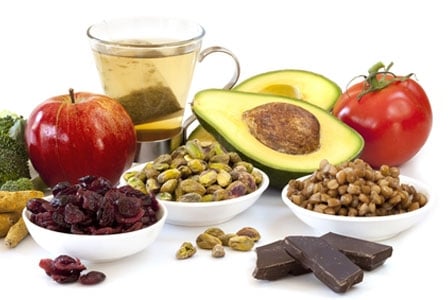
We need certain minerals to build and maintain bones. Calcium is the headliner, of course, while magnesium takes second billing. Silicon, boron, and selenium help boost bone mineral density while zinc, copper, and manganese work in tandem with enzymes to manufacture bone tissue.
We need certain minerals to build and maintain bones. Calcium is the headliner, of course, while magnesium takes second billing. Silicon, boron, and selenium help boost bone mineral density while zinc, copper, and manganese work in tandem with enzymes to manufacture bone tissue.
But minerals are only part of the story: research is starting to uncover the important role that plant nutrients (phytonutrients) play in building better bones.
A is for Antioxidant
Add osteoporosis to the long list of age-related conditions linked to free-radical damage. Free radicals attack–and can even destroy–bone cell membranes. To halt free-radical damage, the body requires a steady supply of antioxidants. A growing body of research shows that certain antioxidants may play a powerful role in protecting bone health. Well-known antioxidant vitamin C, for example, is essential for collagen formation, and collagen is an important component for bone tissue creation and bone strengthening.
More recent research shows that phytonutrient antioxidants may also be key for bone health. The potent antioxidant lycopene, responsible for imparting the colour red to foods such as the tomato, and the polyphenols in colourful fruits and vegetables seem to be of particular importance.
Laudable Lycopene
In a study performed at St. Michael’s Hospital and the University of Toronto, my colleagues and I found that lycopene inhibits the production of free radicals in the cells responsible for bone breakdown (osteoclasts) and stimulates the bone-building cells (osteoblasts).
In the January 2007 issue of Osteoporosis International, we showed that high blood levels of lycopene correlate with lower bone resorption and lower oxidative stress in postmenopausal women between the age of 50 to 60 years who are at high risk of osteoporosis.
An Australian study published in Asia Pacific Journal of Clinical Nutrition (April 2003) also reported that lycopene has a positive effect on bone health. The researchers suggested that bone mass was positively related to dietary lycopene intake in men, and a combination of dietary lycopene and other phytonutrients (lutein and zea-xanthin) in premenopausal women. These and a similar study in my laboratory may demonstrate that lycopene and polyphenols are important in decreasing the risk of osteoporosis in men over the age of 50 years and in pre- and postmenopausal women.
While lycopene is naturally present in foods such as tomatoes, watermelon, and pink grapefruit, it is most abundant in processed tomato products such as tomato paste. An Italian study found that eating 16.5 mg of lycopene in tomato pur?for 21 days boosted blood antioxidant status and resulted in a 33 percent drop in free-radical damage to DNA.
For best bone-building results, some experts recommend you consume at least 7 mg of lycopene daily from food or supplements. Polyphenols found in green tea have also been shown to have beneficial effect on women with osteoporosis.















